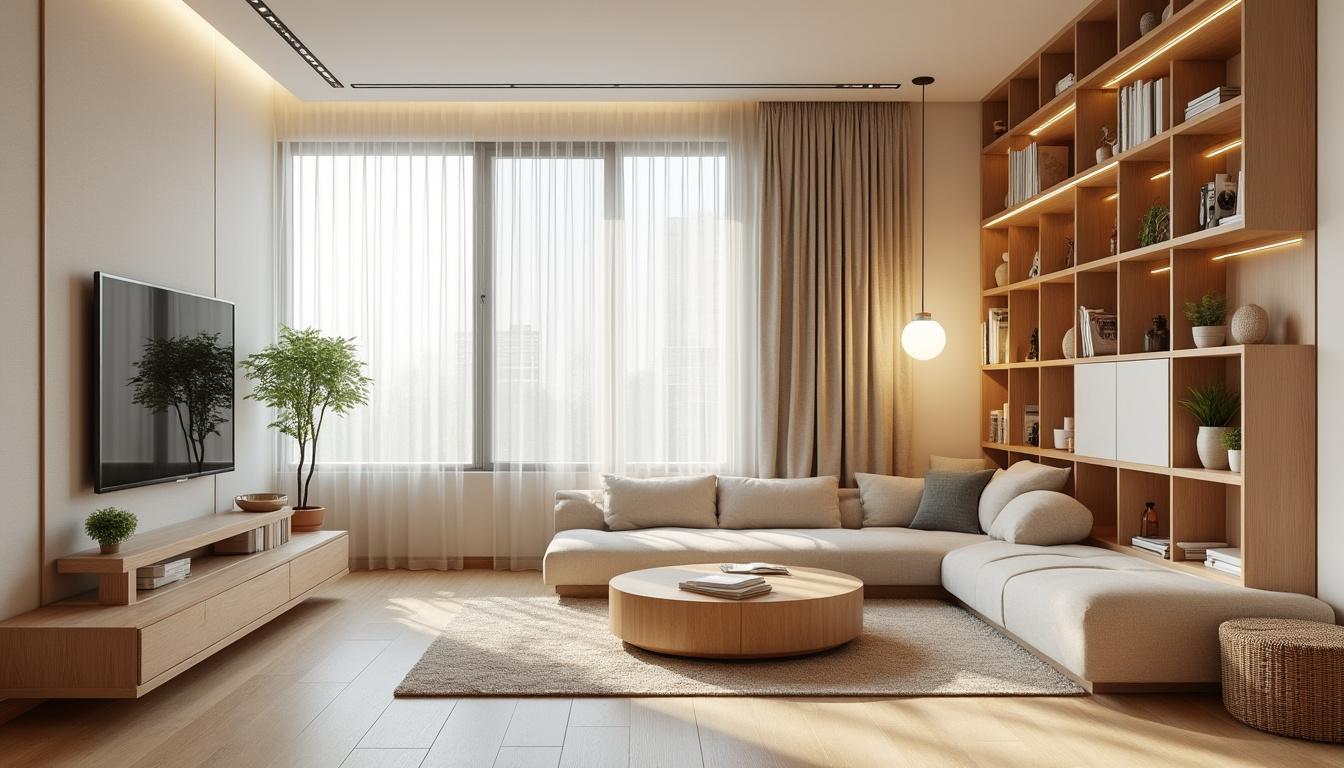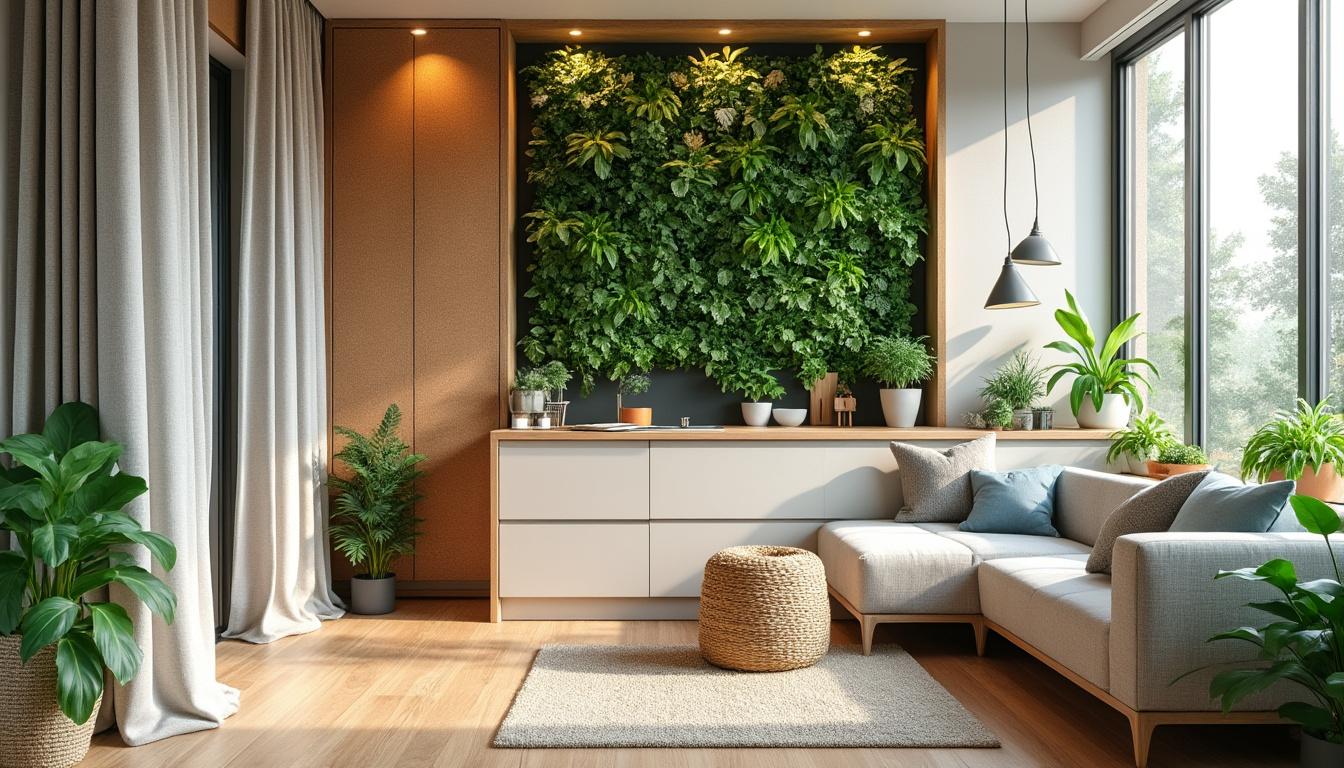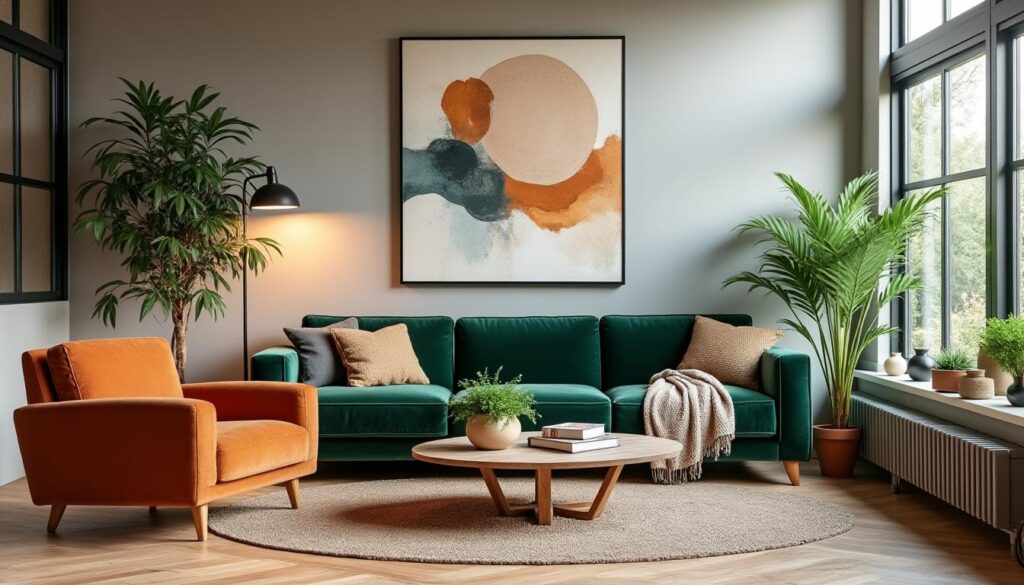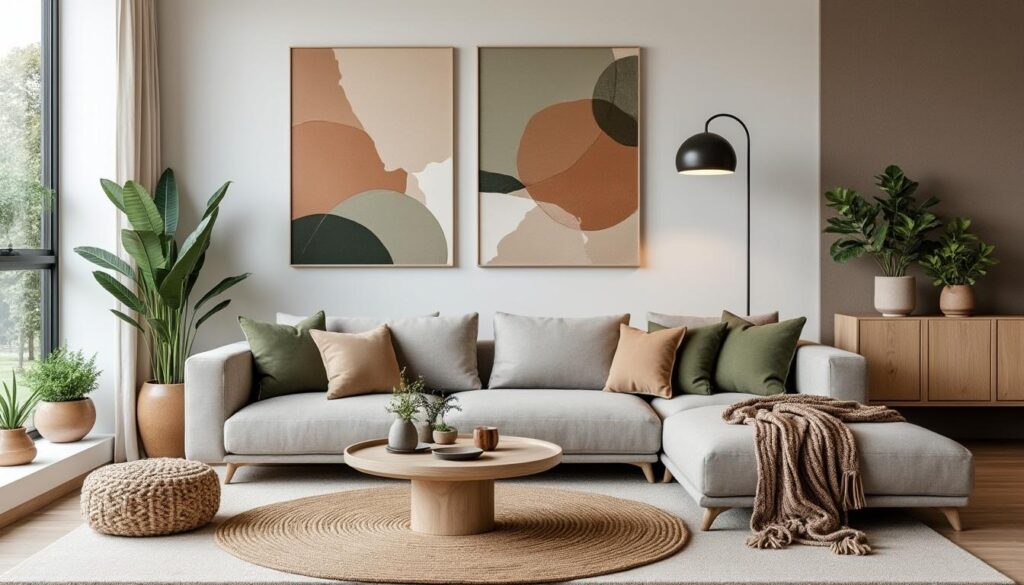Espaços compactos podem ser extremamente funcionais e acolhedores quando recebem soluções simples, inteligentes e sustentáveis. Aqui estão estratégias práticas para que vocês aproveitem cada centímetro com estilo e eficiência.
| Short on time? Here’s the essential: ⏱️ |
|---|
| ✅ Multifunctional furniture saves space and brings flexibility to daily life 🧩 |
| ✅ LED lighting + mirrors visually enlarge and enhance natural light 💡🪞 |
| ✅ Vertical organization and invisible storage keep the home light and practical 📦⬆️ |
| ✅ Plants and natural materials improve comfort, acoustics, and well-being 🌿 |
| ✅ Discrete technology (automation, projector, compact appliances) optimizes functions without cluttering the visual space 📱⚙️ |
Creative ideas for decorating small spaces with multifunctional furniture and flexible layout
In small areas, the layout needs to “work” for you. The key is in multifunctional furniture and a flexible layout that changes throughout the day. A well-sized sofa bed, a foldable wall table, and storage benches transform the living room into a living area, dining room, and guest room without feeling cramped. By prioritizing lightweight pieces with visible legs and rounded corners, circulation flows better and the space feels larger.
In a T1 in Braga, for example, a couple swapped the bulky rack for a lattice shelf that functions as a divider between the living area and home office. The result? Good light passage, more usable zones, and less visual noise. Sliding doors (in cabinets and dividers) also free up turning space — a real gain in narrow layouts.
When every centimeter counts, thinking “top to bottom” prevents mistakes. A bed with drawers eliminates the need for dressers, and a shallow console table at the entrance organizes mail, keys, and masks. In compact kitchens, mobile islands on wheels serve as counters, support tables, and bars, then “park” against the wall. For sustainability, invest in certified wood (FSC), bamboo, and repairable pieces — they last longer and reduce waste.
Layout that adapts to your day: simple steps
- 🧭 Define “zones” by function (living, dining, working) with rugs, lighting, and furniture heights.
- 🧩 Prefer 2-in-1 pieces: sofa bed, extendable table, bench trunk.
- 🧱 Use open dividers (shelves) to segment without blocking light.
- 🚪 Replace swing doors with sliding doors where possible.
- 🔧 Consider custom furniture for “dead” corners and irregular walls.
To avoid overload, the rule is clear: one large piece per wall, the rest light and vertical. Balance between low volumes (sofa, coffee table) and high (shelves) creates a pleasant rhythm.
| Key piece 🪑 | Space benefit ✨ | Sustainable tip 🌱 |
|---|---|---|
| Sofa bed | Hosts without needing an extra room | Recycled fabric + certified foam ♻️ |
| Folding table | Opens at dinner, disappears in routine | Durable hardware, FSC wood ✅ |
| Dividing shelf | Creates zones and lets light circulate | Modular, for reuse during moves 🔁 |
| Bed with drawers | Stores bedding and bags | Non-toxic finish, low VOC emission 🧪 |
The final insight here: the more functions a piece of furniture adds, the fewer items you need to buy and move.
Light, colors, and mirrors: creative ideas for decorating small spaces with maximum amplitude
Bright lighting, a smart color palette, and mirrors in strategic positions can “open” a space without construction. LED bulbs with dimmer create scenes (work, relax, dinner) and enhance light surfaces. Light curtains from ceiling to floor elongate walls and let in more light; heavy fabrics, on the contrary, shorten and darken.
On the walls, light shades (white, beige, light gray) reflect light and calm the eye. A feature wall in a soft blue or sage green adds depth without compressing. In corridors, vertical stripes (paint or wallpaper) “pull” the eye upwards, increasing the perception of height. On the floor, continuity matters: using the same material in integrated environments avoids visual breaks and conveys unity.
Mirrors are powerful allies when they interact with natural light. In small living rooms, a large mirror the width of a console, positioned facing the window, doubles the brightness. In compact bathrooms, a mirror cabinet relieves the countertop and boosts depth. Thin frames and organic shapes bring modernity without weighing down.
Quick tricks that make a difference
- 💡 Install indirect light points aimed at the ceiling for a sense of height.
- 🪞 Place mirrors opposite the window to multiply the light.
- 🪟 Swap heavy blackouts for light linen curtains with lining — controlled light, lighter air.
- 🎨 Paint baseboards and doors the same color as the wall for a “clean” and continuous effect.
- 🧴 Prefer low VOC paints and satin finishes to reflect without glare.
| Element 🎯 | Visual effect 🔎 | Common mistake ⚠️ | Correction ✅ |
|---|---|---|---|
| LED with dimmer | Versatile and comfortable environment | A single central light too strong | Layers: ceiling + wall sconce + table 💡 |
| Light palette | Amplitude and calm | All white “hospital” feel | Light + touches of color and wood 🌳 |
| Large mirror | Instant depth | Mirror on a wall without light | Align with openings and fixtures 🪞 |
| Curtain from ceiling to floor | Ceiling appears higher | Short, heavy curtain | Light fabric, track on the ceiling 🧵 |
In conclusion, good light + right colors + well-placed mirror is the “golden trio” to gain meters without tearing down walls.

Vertical organization and invisible storage: creative ideas for decorating small spaces without clutter
Small space and clutter do not mix. The solution is to work on the vertical axis and create invisible storage that disappears from view. Floating shelves above doors, niches between wall studs, drawers under the bed, and bench trunks in the living room accommodate a lot without cluttering. In kitchens, magnetic knife strips, hooks under cabinets, and corner organizers utilize forgotten areas.
A rule that works is “1 in, 1 out”: for each new item, another goes to donation. The results show up in weeks. Another technique is the “house map”: each item gets a stable “home” (box, drawer, shelf), reducing the time spent searching and chronic disorder. Discreet labels and transparent boxes, especially for small items, speed up the routine.
Laundries and bathrooms need moisture-resistant solutions, such as niches in the shower and coated metal shelves. Sliding doors in cabinets prevent “bumping” in narrow areas. For those living in mezzanines, handrails with built-in shelves store books and plants without blocking passage.
Order checklist that really stays
- 📦 Elevate storage: shelves to the ceiling with a lightweight ladder.
- 🛏️ Use the “basement”: boxes under the bed identified by category.
- 🚪 Doors with function: hooks and pockets on the inside of cabinets.
- 🧲 Metal in favor: magnetic strips and perforated profiles in the kitchen.
- 🧺 Simple categories: “cleaning”, “tools”, “stationery”, “health” 🗂️
| Area 🗺️ | Vertical solution 📐 | Space gain 📈 | Estimated cost 💰 |
|---|---|---|---|
| Living Room | Shelf to the ceiling + niches | Books/decor without taking up floor space | Medium to low 💡 |
| Bedroom | Bed with drawers + tall coat rack | Replaces dresser and trunk | Medium ✅ |
| Kitchen | Hooks, bars, pantry tower | Clear counter for cooking | Low to medium 🍳 |
| Bathroom | Niche in shower + mirror cabinet | Organization without taking up floor space | Medium 🚿 |
For inspiration and practical guides on space-saving in efficient homes, the site Ecopassivehouses.pt gathers useful and up-to-date references.
Practical summary of this section: if there is no floor space, the ceiling and walls take the lead.
Plants, textures, and natural materials: creative ideas for decorating small spaces with well-being
Bringing nature indoors expands the feeling of breathability. In compact apartments, low-maintenance plants and natural textures enhance thermal and acoustic comfort. Succulents, pothos, and zamioculca require little water and accept indirect light; herbs in the kitchen (basil, mint) are fragrant and useful. In free walls, modular vertical gardens create a “living picture” without taking up floor space.
Materials such as linen, wool, sisal, and cork warm up the environment and absorb some noise, an essential gain in open layouts. Natural fiber rugs delineate areas (living, dining) and keep feet comfortable. Light wood coverings (or laminated with good provenance) reflect light and help create a calming look, ideal for those who work from home.
For health and sustainability, prioritize non-toxic finishes and low VOC glues. Ceramic or recycled plastic pots last longer; saucers with stones prevent excessive moisture at the roots. Remember to rotate pots every 15 days for even growth.
Microgardens that fit anywhere
- 🌿 Green shelf with 3 pots: a living line above the sofa or in the kitchen.
- 🪴 Hanging plants (pothos, peperomia) open near the window.
- 🌱 Vertical garden with herbs in wall-mounted modules.
- 💧 Conscious watering: weekly “finger test” and spray bottle on dry days.
- 🧼 Protected base: trays and felts to avoid stains on the floor.
| Plant 🌿 | Light/Water ☀️💧 | Ideal location 📍 | Benefit 🎁 |
|---|---|---|---|
| Pothos | Indirect light / little water | High shelf or hanging | Purifies air + cascading effect 🪴 |
| Zamioculca | Low light / biweekly watering | Corner of living room/bedroom | Resilient + bushy 💪 |
| Succulents | Good light / little water | Sunny window | Low maintenance ⏳ |
| Herbs | Partial direct light / moderate watering | Kitchen/balcony | Flavors + culinary use 🍃 |
Plants and natural textures are not “decorative excess”: they are infrastructure for well-being that works year-round.

Discrete technology and microenvironments: creative ideas for decorating small spaces with more function
Automation and compact appliances solve a lot without stealing space. Smart lamps with dimmer switches and motion sensors save energy and adjust the scene according to the task. Motorized curtains integrated with sunrise improve waking up and regulate thermal gain. In entertainment, projectors replace bulky TVs; retractable screens disappear when not in use.
In small kitchens, combined ovens (microwave + air fryer), slim refrigerators with integrated freezers, and mobile islands double utility. In the bathroom, niches in the shower and sliding doors optimize circulation. For home offices, foldable wall tables and stackable chairs store away in seconds, returning the living room to socializing.
Microenvironments work when each zone has its own light, support surface, and nearby outlet. A rug defines the reading area; an articulated sconce and a compact reclining chair complete the corner. In the entrance, a bench with trunk + coat rack + mirror resolves shoes, coats, and last-minute checks before leaving.
Action plan in 7 days to transform your space
- 🧹 Day 1: quick declutter (3 boxes: donate, recycle, keep).
- 📏 Day 2: measurements and simple layout drawing with zones.
- 🛠️ Day 3: install floating shelves and hooks.
- 💡 Day 4: replace bulbs with LED with dimmer and review lighting points.
- 🪞 Day 5: position a large mirror facing the window.
- 🧩 Day 6: assemble 1 multifunctional piece (folding table or trunk bench).
- 🌿 Day 7: add 3 low-maintenance plants and a defining rug.
| Environment 🏠 | Smart solution 🤖 | Energy impact ⚡ | Usage tip 📝 |
|---|---|---|---|
| Living Room | Projector + motorized curtain | Less consumption than a large TV | Timer to close at the end of the day ⏲️ |
| Kitchen | Compact 2-in-1 appliances | Less standby and heat generated | Use a switch bar with on/off button 🔌 |
| Home office | Wall table + articulated lamp | Focused light, without excess | Color temperature 4000K 🧠 |
| Bedroom | Night presence sensor | Prevents lights from being left on unnecessarily | LED strip under the bed 🌙 |
The main message: good technology is the one that disappears while the space appears.
Immediate action: choose today a multifunctional piece, a well-placed mirror, and a lamp with a dimmer. Three moves, a new space.
{“@context”:”https://schema.org”,”@type”:”FAQPage”,”mainEntity”:[{“@type”:”Question”,”name”:”What colors really enlarge small spaces?”,”acceptedAnswer”:{“@type”:”Answer”,”text”:”Light and neutral tones (warm white, beige, light gray) reflect more light and calm the perception of space. For depth, use a feature wall in a soft tone (gray-blue or sage green). Satin finishes help reflect without creating excessive shine.”}},{“@type”:”Question”,”name”:”Where to position mirrors to avoid mistakes?”,”acceptedAnswer”:{“@type”:”Answer”,”text”:”Align with windows or light sources to multiply brightness. In living rooms, a large mirror facing the window; in corridors, vertical models; in bathrooms, a mirror cabinet. Avoid direct reflections of cluttered areas.”}},{“@type”:”Question”,”name”:”How to create a home office without losing the living room?”,”acceptedAnswer”:{“@type”:”Answer”,”text”:”Adopt a foldable wall table, a stackable chair, and a lattice shelf as a divider. Focused lighting (articulated sconce) and a small rug define the zone. At the end of the day, fold the table and reclaim the social area.”}},{“@type”:”Question”,”name”:”Which plants work best in low light?”,”acceptedAnswer”:{“@type”:”Answer”,”text”:”Zamioculca, pothos, and snake plant tolerate low light and infrequent watering. Position near indirect light, rotate pots biweekly, and control humidity with saucers of stones.”}},{“@type”:”Question”,”name”:”Is it worth investing in automation in compact spaces?”,”acceptedAnswer”:{“@type”:”Answer”,”text”:”Yes, as long as it is discreet and functional: smart lamps with dimmers, motion sensors, and motorized curtains enhance comfort and save energy. Start small (1 to 2 rooms) and expand as needed.”}}]}What colors really enlarge small spaces?
Light and neutral tones (warm white, beige, light gray) reflect more light and calm the perception of space. For depth, use a feature wall in a soft tone (gray-blue or sage green). Satin finishes help reflect without creating excessive shine.
Where to position mirrors to avoid mistakes?
Align with windows or light sources to multiply brightness. In living rooms, a large mirror facing the window; in corridors, vertical models; in bathrooms, a mirror cabinet. Avoid direct reflections of cluttered areas.
How to create a home office without losing the living room?
Adopt a foldable wall table, a stackable chair, and a lattice shelf as a divider. Focused lighting (articulated sconce) and a small rug define the zone. At the end of the day, fold the table and reclaim the social area.
Which plants work best in low light?
Zamioculca, pothos, and snake plant tolerate low light and infrequent watering. Position near indirect light, rotate pots biweekly, and control humidity with saucers of stones.
Is it worth investing in automation in compact spaces?
Yes, as long as it is discreet and functional: smart lamps with dimmers, motion sensors, and motorized curtains enhance comfort and save energy. Start small (1 to 2 rooms) and expand as needed.


